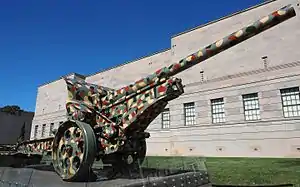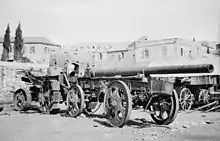| 15 cm Kanone 16 | |
|---|---|
 A 15 cm Kanone 16 on display outside the Australian War Memorial in 2016 | |
| Type | Heavy field gun |
| Place of origin | German Empire |
| Service history | |
| In service | 1917–45 |
| Used by | German Empire Belgium Nazi Germany |
| Wars | World War I World War II |
| Production history | |
| Designer | Krupp |
| Designed | 1917 |
| Manufacturer | Krupp |
| Produced | 1917–18 |
| Variants | 15 cm K 16 im Mrs. Laf. |
| Specifications | |
| Mass | 10,870 kilograms (23,960 lb) |
| Length | 6.81 metres (20 ft) |
| Barrel length | 6.41 metres (21 ft 0 in) L/43[1] |
| Shell | separate-loading, cased charge |
| Shell weight | 51.4 kilograms (113 lb) (HE) |
| Caliber | 149.3 mm (5.88 in) |
| Breech | horizontal sliding-block |
| Carriage | box trail |
| Elevation | -3° to +43° |
| Traverse | 8°[1] |
| Rate of fire | 3 rpm |
| Muzzle velocity | 757 metres per second (2,480 ft/s) |
| Maximum firing range | 22,000 metres (24,000 yd)[1] |
The 15 cm Kanone 16 (15 cm K 16) was a heavy field gun used by Germany in World War I and World War II. Guns turned over to Belgium as reparations after World War I were taken into Wehrmacht service after the conquest of Belgium as the 15 cm K 429(b). It generally served on coast-defense duties during World War II.
Design

The K 16 was a thoroughly conventional design for its day with a box trail, steel wheels for motor transport and a curved gunshield. The axle was suspended on a traverse leaf spring. For transport the barrel was generally detached from the recoil system and moved on its own trailer. In 1941 a small number of K 16 barrels were placed on 21 cm Mrs 18 carriages to become the 15 cm K 16 in Mrs Laf.
Ammunition
It fired 2 types of high-explosive shells, which differed only in which fuzes they could accept. It used a three part charge in its cartridge case. Charge 1 yielded a muzzle velocity of 555 metres per second (1,820 ft/s). Charge 2 replaced Charge 1 in the cartridge case and propelled the shell with a velocity of 696 metres per second (2,280 ft/s). Charge 3 was added to Charge 2 and raised the muzzle velocity to 757 metres per second (2,480 ft/s).[2]
See also
Weapons of comparable role, performance and era
- BL 6 inch Gun Mk XIX British equivalent
- Canon de 155mm GPF French equivalent
References
Citations
Sources
- Engelmann, Joachim and Scheibert, Horst. Deutsche Artillerie 1934-1945: Eine Dokumentation in Text, Skizzen und Bildern: Ausrüstung, Gliederung, Ausbildung, Führung, Einsatz. Limburg/Lahn, Germany: C. A. Starke, 1974.
- Gander, Terry and Chamberlain, Peter. Weapons of the Third Reich: An Encyclopedic Survey of All Small Arms, Artillery and Special Weapons of the German Land Forces 1939-1945. New York: Doubleday, 1979. ISBN 0-385-15090-3.
- Hogg, Ian V. German Artillery of World War Two. 2nd corrected edition. Mechanicsville, PA: Stackpole Books, 1997. ISBN 1-85367-480-X.